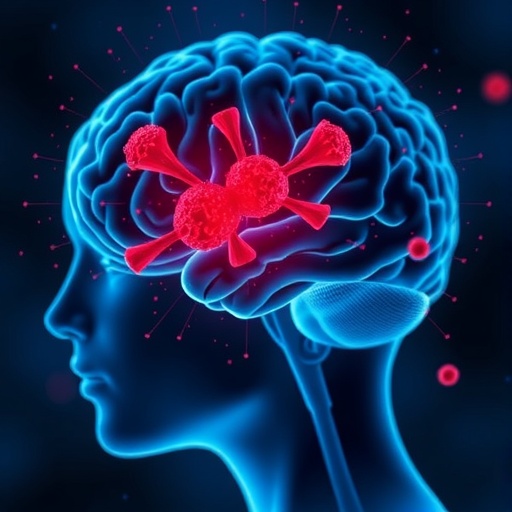In a groundbreaking study published in Translational Psychiatry, researchers have unveiled an extraordinary biological mechanism through which the brain combats anxiety. The study, authored by Mizohata, Yoshioka, Koga, and colleagues, presents compelling evidence that stress-triggered extracellular vesicles (EVs) released in the brain might actually play a powerful therapeutic role in alleviating anxiety-like behaviors. This discovery not only challenges conventional notions about stress responses but also opens promising avenues for innovative anxiety treatments harnessing the brain’s own molecular communication system.
Anxiety disorders represent a massive global challenge with immense personal and societal burden, yet the neurobiological underpinnings of anxiety relief have remained elusive. The new research suggests that the brain’s response to stress does not solely provoke maladaptive effects, but also initiates protective signaling pathways through the secretion of tiny nano-sized EVs. These vesicles, flung out from brain cells, ferry complex biologically active cargo capable of modulating neural circuits integral to anxiety regulation.
Extracellular vesicles are lipid bilayer-enclosed particles released by cells, carrying proteins, lipids, RNA, and other molecular information that facilitates intercellular communication. While their role in various diseases has been studied extensively, this is among the first investigations to demonstrate that brain-derived EVs formed strictly under stress conditions may counterbalance anxiety. The authors meticulously isolated and characterized these vesicles from rodent models subjected to chronic stress paradigms.
The team observed that stressed animals secreted EVs with distinct molecular signatures compared to controls. These stress-elicited EVs were enriched in signaling molecules implicated in synaptic plasticity, neuroinflammation modulation, and neurotransmitter regulation—key processes intimately tied to anxiety pathophysiology. When administered to other anxiety-prone rodents, the EVs remarkably reduced avoidance behavior and hypervigilance without affecting basic motor functions or cognition.
Further molecular analyses revealed that these vesicles were abundant in microRNAs known to suppress pro-anxiety pathways and promote neurotrophic factors that aid neural resilience. This dual cargo profile potentially reprograms the recipient neural circuits, fostering synaptic remodeling conducive to emotional stability and reduced anxiety. The specificity of these effects was confirmed by EVs isolated from non-stressed animals, which did not yield comparable results.
The implications of these findings reverberate deeply across clinical neuroscience. They suggest the brain itself deploys an intrinsic compensatory tool responding to stress events—an endogenous protective mechanism harnessing EVs to mitigate anxiety and maintain homeostasis. This runs counter to the often overwhelmingly negative portrayal of stress responses and showcases a finely tuned neurobiological balancing act.
From a translational perspective, engineering stress-associated EVs or mimicking their cargo profiles may revolutionize approaches to anxiety disorders. Traditional pharmacotherapies frequently exhibit limited efficacy and adverse effects, impeding long-term compliance. In contrast, EV-based interventions could offer precision targeting, reduced systemic toxicity, and novel mechanistic bases rooted in natural communication systems inherent in brain biology.
However, significant challenges remain before therapeutic applications can be realized. Scalably producing brain-specific EVs with fidelity, ensuring stable delivery into the central nervous system, and delineating precise dose-response relationships necessitate further rigorous study. Moreover, the risk of off-target effects and immune reactions requires comprehensive profiling in larger animal models and ultimately human trials.
Notably, this research also ignites questions about the role of EVs in other psychiatric and neurological disorders linked to stress, such as depression and post-traumatic stress disorder. Could modulating EV release or composition offer a universal strategy for brain health? The intricate dance of cell-to-cell communication conveyed by EVs may hold untapped potential beyond anxiety alone.
The study employed cutting-edge nanotechnology to isolate these vesicles, combining advanced ultracentrifugation and state-of-the-art high-resolution electron microscopy. This technical rigor afforded an unprecedented glimpse into the molecular contents and biophysical properties of vesicles triggered specifically by stress. Such methodological innovations pave the way for future explorations into the brain’s secret language encoded via vesicles.
Moreover, behavioral assays in this investigation were carefully designed to capture nuanced anxiety-related phenotypes, incorporating open field, elevated plus maze, and light-dark box tests. The convergence of molecular analyses with robust behavioral outcomes lends considerable weight to the conclusions, bridging molecular neuroscience with behavioral psychology vividly.
The discovery that stressful stimuli incite beneficial brain EVs underscores the complexity and adaptability of neural networks. While chronic stress remains a health hazard, the brain’s capacity to self-protect through vesicle-mediated signaling epitomizes biological resilience. These findings paint stress not solely as a destructive force but as a trigger inducing countermeasures at the nanoscale, opening conceptual doors to revising how psychological stress is understood and addressed.
Ultimately, this research heralds a new frontier in neuropsychiatry where harnessing endogenous extracellular vesicles might transform mental health management. The ability to manipulate tiny biological messengers altering anxiety circuits with precision promises a paradigm shift. As researchers deepen understanding of EV biology, unlock cargo delivery mechanisms, and refine therapeutic designs, anxiety disorders could witness more targeted, effective, and personalized interventions born from our own brain’s molecular toolkit.
With anxiety disorders impacting millions worldwide and prevailing treatments leaving many patients dissatisfied, this breakthrough offers hope grounded in nature’s ingenuity. The intricate communication between brain cells via stress-induced EVs illuminates a sophisticated self-help mechanism embedded within neural tissue. Future endeavors translating these insights may ultimately enable clinicians to “send” therapeutic vesicles into vulnerable brains, paving the way to anxiety relief through finely tuned biological messages honed by evolution.
This landmark study not only enriches our understanding of how stress shapes brain function at a molecular level but also inspires profound excitement about biotechnological applications leveraging extracellular vesicles. As science uncovers ever more about these minuscule yet mighty particles, the prospect of decoding and harnessing the brain’s own signals to heal anxiety holds transformative promise for psychiatric medicine.
Subject of Research: Stress-induced brain extracellular vesicles and their role in ameliorating anxiety behavior.
Article Title: Stress-induced brain extracellular vesicles ameliorate anxiety behavior.
Article References:
Mizohata, Y., Yoshioka, Y., Koga, M. et al. Stress-induced brain extracellular vesicles ameliorate anxiety behavior. Transl Psychiatry (2025). https://doi.org/10.1038/s41398-025-03754-0
Image Credits: AI Generated




